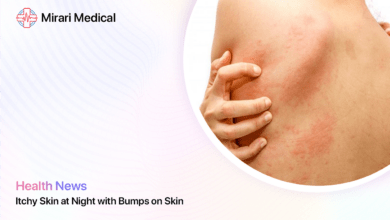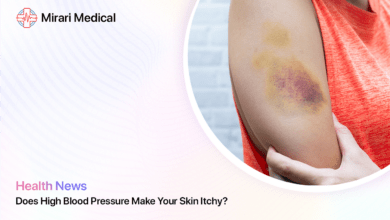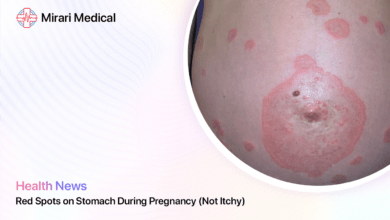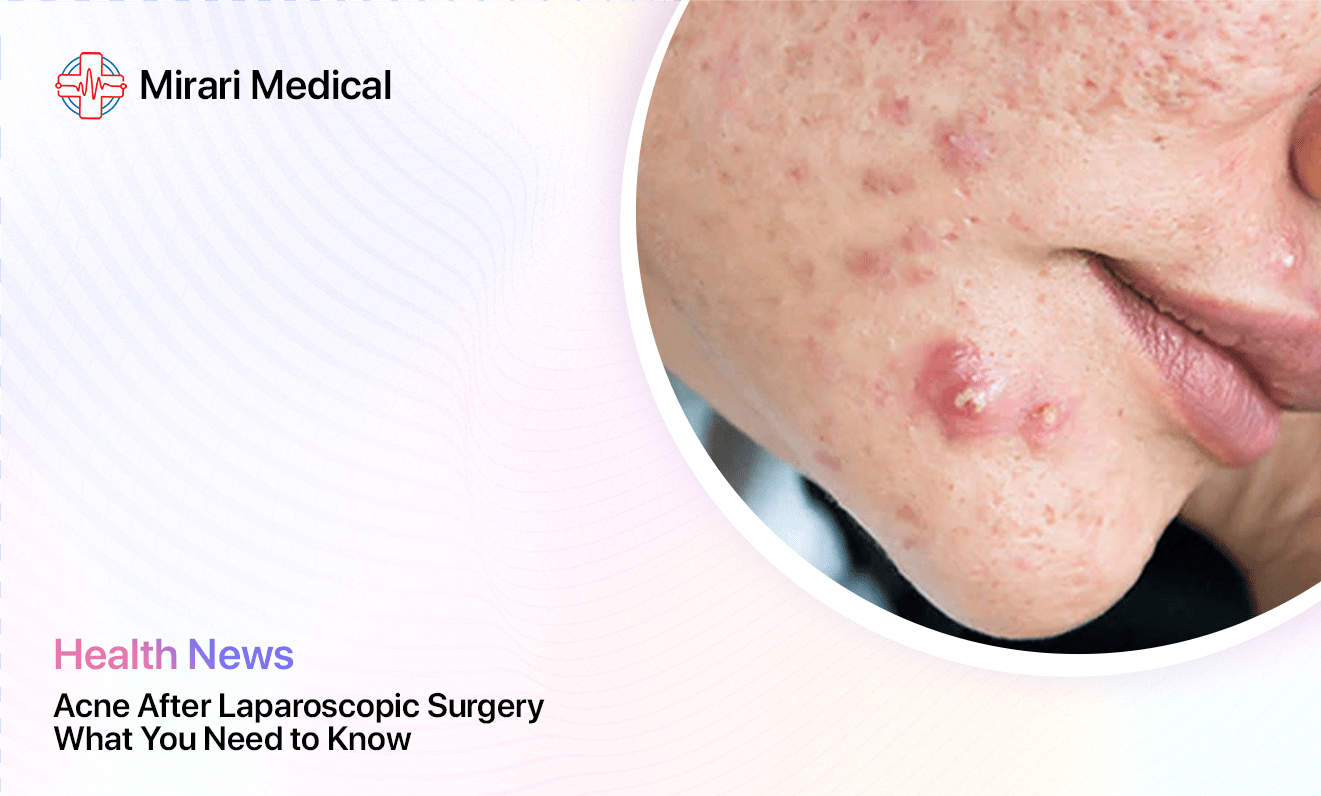Why Do I Have Red Dots on My Skin Itchy?
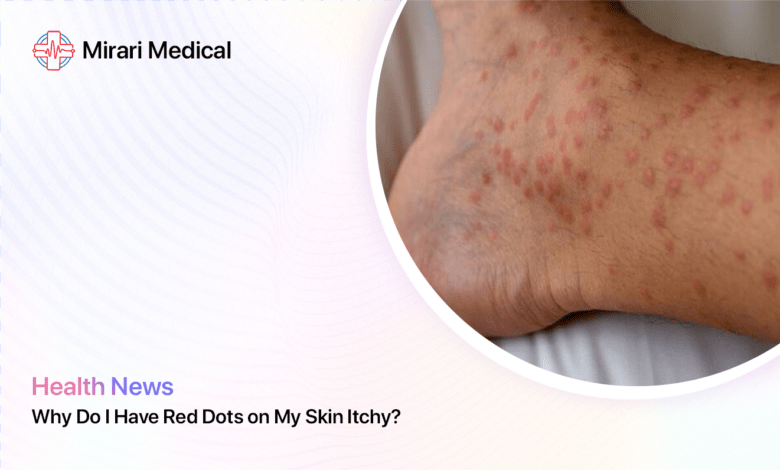
You may be interested
Have you ever noticed small, itchy red dots appearing on your skin? You’re not alone. Many people experience this common skin issue at some point in their lives. These pesky red bumps can be uncomfortable, unsightly, and sometimes even a sign of an underlying health condition. In this article, we’ll dive deep into the world of itchy red dots on the skin, exploring their causes, symptoms, diagnosis, treatment options, and prevention strategies. By the end, you’ll have a better understanding of this skin problem and know when it’s time to seek medical advice.
What Are Red Dots on Skin?
Red dots on the skin, also known as a rash, are a common skin symptom that can appear as small, itchy, red bumps or spots. These dots can occur in clusters on various parts of the body, such as the face, neck, arms, legs, or torso[1]. The appearance of the red dots may vary depending on the underlying cause and your skin tone. On lighter skin, they often appear as bright red or pink bumps, while on darker skin, they may look more purple, brown, or darker than the surrounding skin[2].
What Are The Causes Of Red Dots On Skin?
There are numerous potential causes of itchy red dots on the skin. Some common culprits include:
1. Allergic Reaction
An allergic reaction occurs when your immune system overreacts to a typically harmless substance, such as food, medication, or environmental factors like pollen or pet dander. This can cause symptoms like itchy, red, raised bumps on the skin (hives), along with other signs like swelling, difficulty breathing, or digestive issues[3]. Contact dermatitis is a specific type of allergic reaction that happens when your skin comes into direct contact with an allergen, such as nickel in jewelry or certain chemicals in skincare products[4].
2. Insect Bites
Insect bites from mosquitoes, fleas, bedbugs, or other pests can cause localized itchy, red bumps on the skin. These bites often appear in clusters or lines on exposed areas of the body[5]. In some cases, people may experience a more severe allergic reaction to insect bites, leading to extensive swelling, pain, or difficulty breathing, which requires immediate medical attention.
3. Skin Infections
Various bacteria, viruses, and fungi can cause skin infections that manifest as itchy red dots or bumps. Some examples include:
- Folliculitis: An infection of the hair follicles that causes small, red, itchy bumps[6]
- Impetigo: A bacterial infection that leads to red sores or blisters, often around the mouth and nose[7]
- Shingles: A viral infection caused by the same virus as chickenpox, resulting in a painful, blistering rash[8]
- Ringworm: A fungal infection that causes a circular, red, itchy rash[9]
4. Autoimmune Disorders
Autoimmune disorders occur when the body’s immune system mistakenly attacks healthy cells, leading to inflammation and various symptoms, including skin issues. Some autoimmune conditions that can cause itchy red dots on the skin include:
- Psoriasis: A chronic condition that causes thick, red, scaly patches on the skin[10]
- Lupus: A systemic autoimmune disorder that can cause a distinctive “butterfly rash” across the cheeks and nose[11]
- Dermatomyositis: A rare condition that leads to a distinctive red or purple rash on the face, chest, and hands[12]
5. Medications
Certain medications can cause an allergic reaction or side effect that manifests as itchy red dots on the skin. This is known as a drug rash or drug eruption. Some common culprits include antibiotics, non-steroidal anti-inflammatory drugs (NSAIDs), and chemotherapy medications[13]. If you suspect a medication is causing your skin symptoms, consult your doctor immediately.
6. Heat Rash
Heat rash, also called prickly heat or miliaria, occurs when sweat ducts become blocked and sweat gets trapped under the skin. This can lead to small, itchy, red bumps or blisters, usually in areas where skin rubs together, such as the neck, armpits, or under the breasts[14]. Heat rash is more common in hot, humid weather and can affect people of all ages.
What Are The Symptoms Of Red Dots On Skin?
The symptoms associated with itchy red dots on the skin can vary depending on the underlying cause. However, some common signs to look out for include:
- Small, red, itchy bumps or spots on the skin
- Clusters of bumps that may be filled with clear or yellowish fluid
- Dry, flaky, or scaly skin surrounding the red dots
- Swelling, pain, or tenderness in the affected area
- A burning or stinging sensation on the skin
- Fever, chills, or other flu-like symptoms (in cases of infection)
It’s important to note that the appearance of red dots on the skin can differ based on your skin tone. On darker skin, the dots may appear more purple, brown, or hyperpigmented compared to the surrounding skin[15].
How Are Red Dots On Skin Diagnosed?
If you’re experiencing persistent or severe itchy red dots on your skin, it’s crucial to seek medical advice from a healthcare professional. They can help diagnose the underlying cause and recommend appropriate treatment options. During your appointment, your doctor will:
- Take a thorough medical history, asking about your symptoms, any recent exposures or triggers, and your family history of skin conditions.
- Perform a physical examination, carefully inspecting the affected areas of your skin and noting the appearance, distribution, and any associated symptoms.
- In some cases, your doctor may recommend additional tests to confirm a diagnosis or rule out certain conditions. These may include:
- Blood tests to check for signs of infection or autoimmune disorders
- Skin scrapings or biopsies to examine under a microscope for signs of fungal or bacterial infections
- Allergy tests to identify potential allergens triggering your symptoms
Based on the results of your examination and any necessary tests, your doctor can provide an accurate diagnosis and develop a personalized treatment plan to address your specific condition.
What Are The Treatment Options For Red Dots On Skin?
The treatment options for itchy red dots on the skin will depend on the underlying cause and severity of your symptoms. Some common approaches include:
1. Topical Creams or Ointments
For mild to moderate cases, your doctor may recommend topical creams or ointments to help soothe itching, reduce inflammation, and promote healing. These may include:
- Over-the-counter (OTC) hydrocortisone cream to relieve itching and inflammation
- Prescription-strength corticosteroid creams for more severe cases
- Antifungal or antibacterial creams to treat skin infections
- Calamine lotion or menthol-based creams to provide a cooling, soothing effect
2. Oral Medications
In some cases, your doctor may prescribe oral medications to help manage your symptoms or treat an underlying condition. These may include:
- Antihistamines to reduce itching and inflammation associated with allergic reactions
- Antibiotics to treat bacterial skin infections
- Antiviral medications to manage viral infections like shingles
- Immunosuppressants to control autoimmune disorders affecting the skin
3. Home Remedies
In addition to medical treatments, there are several home remedies that may help alleviate the symptoms of itchy red dots on the skin:
- Applying cool compresses to the affected area to reduce itching and inflammation
- Taking lukewarm baths with colloidal oatmeal or baking soda to soothe irritated skin
- Using fragrance-free, hypoallergenic moisturizers to keep skin hydrated and prevent further irritation
- Avoiding hot showers, harsh soaps, and tight-fitting clothing that can aggravate symptoms
It’s essential to consult with your doctor before trying any home remedies, as some may not be suitable for your specific condition or could interact with other medications you’re taking.
When Should I See A Doctor For Red Dots On Skin?
While many cases of itchy red dots on the skin can be managed at home, there are certain situations where it’s crucial to seek medical advice. See your doctor if:
- Your symptoms are severe, widespread, or rapidly worsening
- The red dots are accompanied by other concerning symptoms like fever, chills, or difficulty breathing
- You suspect the red dots may be a sign of an underlying health condition, such as an autoimmune disorder or infection
- Over-the-counter treatments and home remedies fail to provide relief after several days
- The affected areas are painful, oozing, or showing signs of infection, such as swelling, warmth, or red streaks
In rare cases, red dots on the skin can be a sign of a serious medical emergency, such as meningitis. If you or someone you know develops a rash along with symptoms like high fever, neck stiffness, confusion, or sensitivity to light, seek immediate medical attention[16].
How Can I Prevent Red Dots On Skin?
While not all cases of itchy red dots on the skin can be prevented, there are several steps you can take to reduce your risk:
- Identify and avoid known triggers, such as allergens or irritants that cause contact dermatitis. This may involve switching to hypoallergenic skincare products, using protective gloves when handling chemicals, or avoiding certain foods if you have a known allergy.
- Practice good skin hygiene by washing regularly with gentle, fragrance-free cleansers and moisturizing to keep skin hydrated and healthy.
- Protect your skin from excessive sun exposure, which can worsen certain conditions like lupus or psoriasis. Use a broad-spectrum sunscreen with an SPF of at least 30 and wear protective clothing when spending time outdoors.
- Manage stress through relaxation techniques, as stress can trigger or exacerbate some skin conditions like eczema or psoriasis.
- Stay up to date on vaccinations, particularly those that protect against viral infections known to cause skin rashes, such as chickenpox and shingles.
- If you have a chronic skin condition like atopic dermatitis or psoriasis, work with your doctor to develop a long-term management plan to keep symptoms under control and prevent flare-ups.
By taking proactive steps to care for your skin and address any underlying health issues, you can help minimize the occurrence of itchy red dots and maintain overall skin health.
What Are The Possible Complications Of Red Dots On Skin?
In most cases, itchy red dots on the skin are a temporary, albeit annoying, issue that resolves with proper treatment. However, in some instances, complications can arise, especially if the underlying cause is not addressed promptly. Potential complications include:
- Secondary skin infections: Constantly scratching or picking at the affected areas can lead to open wounds or sores, increasing the risk of bacterial infections like cellulitis or impetigo[17].
- Scarring or hyperpigmentation: Severe or prolonged cases of certain conditions, such as eczema or psoriasis, can cause permanent skin changes like scarring or dark spots (hyperpigmentation), particularly on darker skin tones[18].
- Spread of infection: If the red dots are caused by a contagious infection like impetigo or ringworm, failing to treat the condition promptly can lead to the spread of infection to other parts of the body or other people.
- Worsening of underlying health conditions: In some cases, itchy red dots on the skin may be a sign of an undiagnosed or poorly managed health issue, such as an autoimmune disorder or allergy. Delaying diagnosis and treatment can allow the underlying condition to progress and cause more serious complications.
To minimize the risk of complications, it’s essential to seek medical advice if your symptoms are severe, persistent, or fail to respond to over-the-counter treatments. Your doctor can help identify the root cause of your skin issues and recommend appropriate treatment options to promote healing and prevent further problems.
FAQs
What causes little red dots on skin that itch?
Little red dots on the skin that itch can be caused by various factors, including allergic reactions, insect bites, skin infections, autoimmune disorders, medications, and heat rash. Identifying the specific cause often requires a thorough evaluation by a healthcare professional.
How do you treat red itchy spots?
Treatment for red itchy spots depends on the underlying cause but may include topical creams or ointments to relieve itching and inflammation, oral medications to address infections or autoimmune disorders, and home remedies like cool compresses or oatmeal baths to soothe irritated skin. Consult your doctor for personalized treatment options.
What are tiny pin-sized red dots on skin?
Tiny pin-sized red dots on the skin, also known as petechiae, are usually caused by bleeding under the skin due to broken capillaries. While some cases may be harmless and resolve on their own, petechiae can also be a sign of more serious conditions like leukemia, meningitis, or a bleeding disorder[19]. If you notice petechiae on your skin, it’s best to seek medical advice to determine the cause.
Why am I getting petechiae all of a sudden?
Sudden onset of petechiae can be caused by various factors, including injuries, infections, medications, or underlying health conditions. In some cases, petechiae may develop after intense coughing, vomiting, or crying, which can cause small blood vessels to burst. If you experience petechiae without a clear cause, consult your doctor for proper diagnosis and treatment.
Why do I get petechiae when I scratch?
Petechiae can appear when you scratch your skin due to the rupture of tiny blood vessels (capillaries) beneath the skin’s surface. This can be more noticeable in people with sensitive or thin skin, or those taking medications that affect blood clotting. If you frequently develop petechiae after scratching, mention this to your doctor to rule out any underlying issues.
What do leukemia red dots look like?
In some cases, leukemia can cause small, flat, red or purple dots on the skin called petechiae. These dots, which resemble a rash, occur due to low platelet counts and bleeding under the skin. However, it’s important to note that not all cases of petechiae are caused by leukemia, and other symptoms like fatigue, fever, and easy bruising or bleeding are often present. If you suspect leukemia, consult your doctor immediately for proper evaluation and diagnosis.
Takeaways
- Itchy red dots on the skin can have various causes, including allergic reactions, insect bites, infections, autoimmune disorders, medications, and heat rash.
- Symptoms may vary depending on the underlying cause but often include small, red, itchy bumps or spots that may appear in clusters.
- Diagnosis typically involves a thorough medical history, physical examination, and possibly additional tests like blood work or skin biopsies.
- Treatment options depend on the specific cause but may include topical creams, oral medications, and home remedies to relieve symptoms and address the underlying issue.
- Seek medical advice if symptoms are severe, persistent, or accompanied by other concerning signs like fever or difficulty breathing.
- Prevention strategies include identifying and avoiding triggers, practicing good skin hygiene, protecting skin from sun damage, managing stress, staying up to date on vaccinations, and working with your doctor to manage chronic skin conditions.
- Potential complications of untreated or severe cases may include secondary infections, scarring, spread of infection, or worsening of underlying health issues.
If you experience itchy red dots on your skin, don’t ignore the problem. Pay attention to your symptoms, take steps to care for your skin, and consult with a healthcare professional if needed. By being proactive and informed, you can effectively manage this common skin concern and maintain healthy, comfortable skin.
References
- American Academy of Dermatology. (n.d.). Rash 101 in adults: When to seek medical treatment. Retrieved April 13, 2023, from https://www.aad.org/public/diseases/rashes/rash-in-adults-seek-treatment
- Skin of Color Society. (2020). Skin Manifestations in People of Color. Retrieved April 13, 2023, from https://skinofcolorsociety.org/dermatology-education/skin-manifestations-in-people-of-color/
- Mayo Clinic. (2021). Hives and angioedema. Retrieved April 13, 2023, from https://www.mayoclinic.org/diseases-conditions/hives-and-angioedema/symptoms-causes/syc-20354908
- Braun-Falco, O., Plewig, G., Wolff, H. H., & Burgdorf, W. H. C. (2013). Dermatology (2nd ed.). Springer Science & Business Media.
- Steen, C. J., Carbonaro, P. A., & Schwartz, R. A. (2004). Arthropods in dermatology. Journal of the American Academy of Dermatology, 50(6), 819-842.
- Luelmo-Aguilar, J., & Santandreu, M. S. (2004). Folliculitis: recognition and management. American Journal of Clinical Dermatology, 5(5), 301-310.
- Cole, C., & Gazewood, J. (2007). Diagnosis and treatment of impetigo. American Family Physician, 75(6), 859-864.
- Cohen, J. I. (2013). Herpes zoster. New England Journal of Medicine, 369(3), 255-263.
- Ely, J. W., Rosenfeld, S., & Seabury Stone, M. (2014). Diagnosis and management of tinea infections. American Family Physician, 90(10), 702-710.
- Boehncke, W. H., & Schön, M. P. (2015). Psoriasis. The Lancet, 386(9997), 983-994.
- Kuhn, A., Landmann, A., & Bonsmann, G. (2014). Cutaneous lupus erythematosus. In Dubois’ lupus erythematosus and related syndromes (pp. 333-340). W.B. Saunders.
- Callen, J. P., & Wortmann, R. L. (2006). Dermatomyositis. Clinics in Dermatology, 24(5), 363-373.
- Roujeau, J. C. (2005). Clinical heterogeneity of drug hypersensitivity. Toxicology, 209(2), 123-129.
- Mowad, C. M., Anderson, B., Scheinman, P., Pootongkam, S., Nedorost, S., & Brod, B. (2016). Allergic contact dermatitis: patient management and education. Journal of the American Academy of Dermatology, 74(6), 1043-1054.
- Taylor, S. C., & Summers, P. (2009). Defining skin of color. Cutis, 84(2 Suppl), 2-5.
- Thompson, A. E., Shedd, L. E., & Larson, M. J. (2022). Meningitis. JAMA, 327(3), 296-296.
- Stevens, D. L., Bisno, A. L., Chambers, H. F., Dellinger, E. P., Goldstein, E. J., Gorbach, S. L., … & Wade, J. C. (2014). Practice guidelines for the diagnosis and management of skin and soft tissue infections: 2014 update by the Infectious Diseases Society of America. Clinical Infectious Diseases, 59(2), e10-e52.
- Davis, E. C., & Callender, V. D. (2010). Postinflammatory hyperpigmentation: a review of the epidemiology, clinical features, and treatment options in skin of color. The Journal of Clinical and Aesthetic Dermatology, 3(7), 20.
- Gauer, R. L., & Braun, M. M. (2012). Thrombocytopenia. American Family Physician, 85(6), 612-622.
Your trusted source for health info, offering expert advice, news, and tips to stay healthy and informed.

